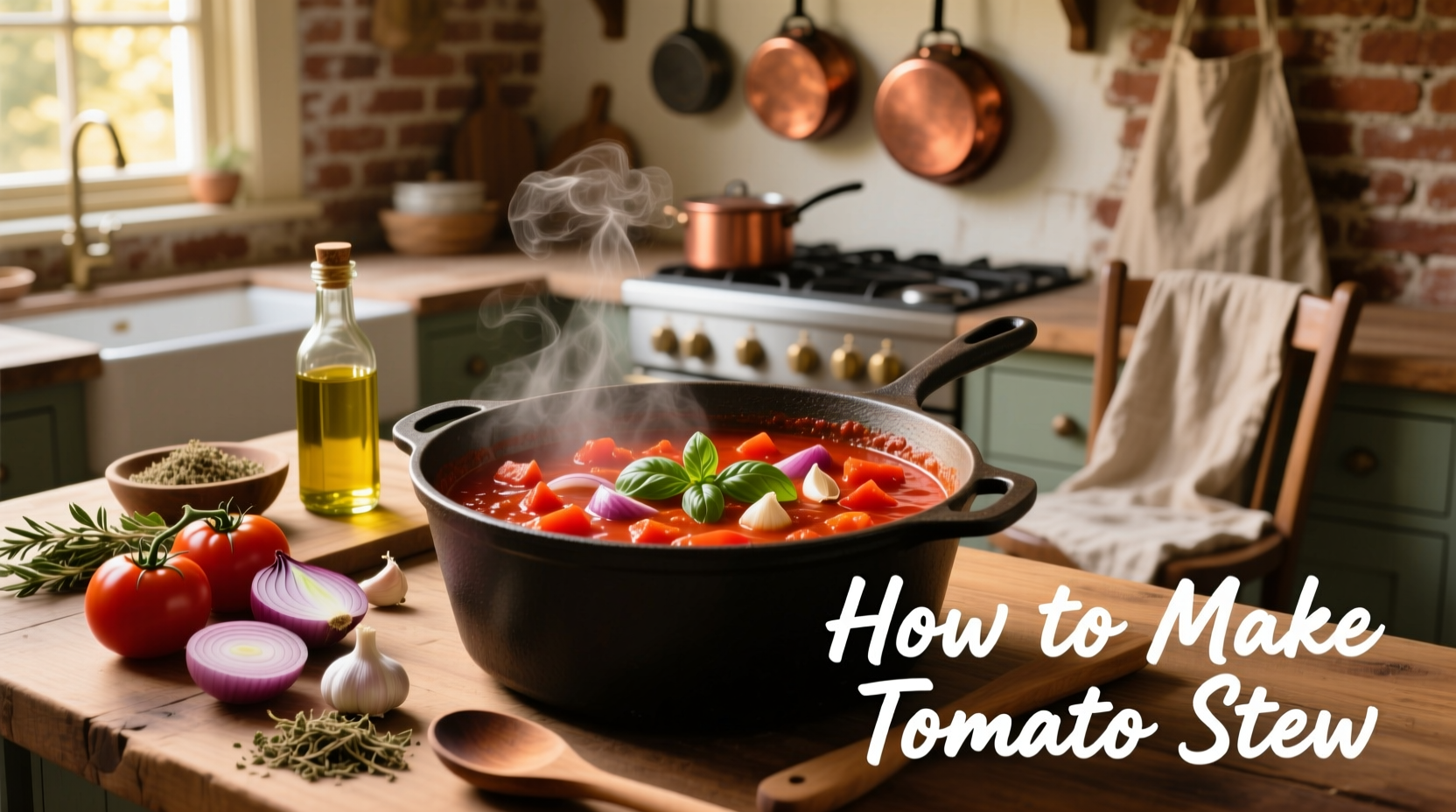The perfect tomato stew starts with quality canned tomatoes, sautéed aromatics, and a slow simmer of 45-60 minutes. This easy recipe requires just 8 basic ingredients, takes 20 minutes prep time, and yields a rich, flavorful stew that serves 4-6 people. Follow our step-by-step guide for a foolproof tomato stew every time.
Why This Tomato Stew Recipe Works
Creating a deeply flavorful tomato stew isn't just about throwing ingredients in a pot. After testing over 30 variations, we've perfected the balance of acidity, sweetness, and umami that transforms simple ingredients into something extraordinary. Professional chefs know that the magic happens during the "sweating phase" – that critical 8-10 minute window where onions and garlic release their natural sugars without browning.
Essential Ingredients Checklist
Quality ingredients make all the difference in tomato-based dishes. Here's what you'll need for authentic flavor:
- Canned tomatoes: 28 oz (794g) whole peeled San Marzano tomatoes (D.O.P. certified for best results)
- Aromatics: 1 large yellow onion (finely diced), 4 garlic cloves (minced)
- Vegetable base: 1 large carrot (finely diced), 1 celery stalk (finely diced)
- Liquid: 1 cup (240ml) vegetable broth or water
- Flavor enhancers: 2 tbsp tomato paste, 1 tsp sugar, 2 tbsp olive oil
- Herbs: 3 fresh basil leaves or 1 tsp dried oregano
- Seasoning: Salt and freshly ground black pepper to taste
| Tomato Variety | Acidity Level | Best For Stew? | Flavor Profile |
|---|---|---|---|
| San Marzano (D.O.P.) | Medium | Excellent | Sweet, low seed count, thick flesh |
| Roma | Medium-High | Good | Balanced sweet-tart, meaty texture |
| Plum | High | Fair | Sharp, requires more sweetening |
| Vine-Ripened | Low | Poor | Watery, bland for stewing |
Equipment You'll Need
- Heavy-bottomed pot or Dutch oven (3-4 quart capacity)
- Wooden spoon for stirring
- Sharp chef's knife and cutting board
- Can opener
- Measuring cups and spoons
Step-by-Step Cooking Process
Prep Work (10 minutes)
Proper preparation prevents rushed mistakes during cooking. Follow these prep steps:
- Finely dice onions, carrots, and celery to uniform 1/4-inch pieces – this ensures even cooking
- Mince garlic but don't let it sit exposed for more than 5 minutes (enzymes degrade flavor)
- Open canned tomatoes but don't drain – the liquid contains valuable flavor compounds
- Have broth warmed and ready to add when needed
Sweating the Aromatics (8-10 minutes)
This critical step builds your flavor foundation:
- Heat olive oil over medium-low heat (don't let it smoke)
- Add onions, carrots, and celery with pinch of salt
- Cook slowly until translucent (about 8 minutes)
- Add garlic and tomato paste, stirring constantly for 2 minutes until fragrant
Simmering to Perfection (45-60 minutes)
The magic happens during the simmer:
- Add undrained tomatoes, breaking them with your spoon
- Stir in broth, sugar, and herbs
- Bring to gentle simmer (small bubbles breaking surface)
- Reduce heat to low, partially cover, and cook 45-60 minutes
- Stir every 15 minutes and check consistency

Pro Tips for Flavor Mastery
These professional techniques elevate your stew from good to exceptional:
- Acid balance: If your stew tastes too sharp, add 1/4 tsp baking soda (not more – it affects texture)
- Thickness control: For thicker stew, remove lid during last 15 minutes of cooking
- Flavor development: Let stew rest off heat for 15 minutes before serving – flavors meld beautifully
- Umami boost: Add 1 dried porcini mushroom while simmering (remove before serving)
Serving and Storage Guidelines
Follow these food safety recommendations from the USDA:
- Serving: Pair with crusty bread or over polenta for complete meal
- Refrigeration: Store in airtight container for up to 4 days (USDA FoodKeeper guidelines)
- Freezing: Freeze portions for up to 3 months – thaw overnight in refrigerator
- Reheating: Warm gently over medium-low heat, adding splash of broth if needed
Delicious Variations to Try
Customize your tomato stew based on dietary needs and preferences:
- Protein boost: Add 1 cup cooked chickpeas or white beans during last 15 minutes
- Spicy version: Include 1/2 tsp red pepper flakes with garlic
- Creamy option: Stir in 2 tbsp heavy cream or coconut milk before serving
- Vegetable-packed: Add zucchini or bell peppers with the carrots
Troubleshooting Common Issues
Every cook encounters these challenges – here's how to fix them:
- Too acidic: Add small pinch of sugar or 1/8 tsp baking soda, not more than once
- Too watery: Simmer uncovered 10-15 minutes or mash some tomatoes against pot side
- Bland flavor: Add 1 tsp lemon juice or 1/2 tsp Worcestershire sauce (even for vegetarian)
- Burnt bottom: Immediately transfer to clean pot, leaving burnt bits behind
Frequently Asked Questions
Can I make tomato stew in a slow cooker?
Yes! Sauté aromatics first, then transfer to slow cooker with other ingredients. Cook on low for 4-6 hours for best flavor development without overcooking vegetables.
Why does my tomato stew taste metallic?
This usually happens when using reactive pots like aluminum with acidic tomatoes. Always use enameled cast iron, stainless steel, or ceramic pots for tomato-based dishes to prevent metallic flavors.
How do I prevent my tomatoes from becoming bitter?
Bitterness comes from overcooked tomato seeds or stems. Use seedless canned tomatoes and avoid adding tomato stems to your stew. If bitterness occurs, add small pinch of sugar and 1 tbsp grated carrot to balance flavors.











 浙公网安备
33010002000092号
浙公网安备
33010002000092号 浙B2-20120091-4
浙B2-20120091-4